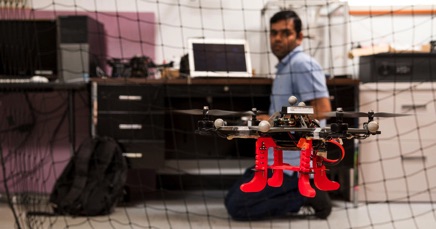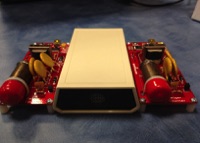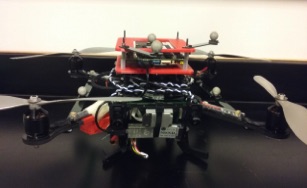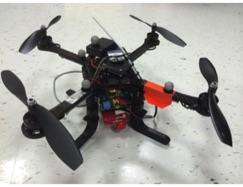Overview
In this collaborative project with Los Alamos National Laboratory, the goal is to develop smart aerial networks of radiation detectors, capable of identifying very weak mobile sources of radioactivity, within constrained and GPS-denied environments.
Mobile radiation detection networks can offer an additional layer of safety and security against the release and/or proliferation or radiological agents. For these detector networks to scale, the sensors themselves have to be lightweight and relatively inexpensive, so that they can be deployed in numbers. Using commercial off-the-shelf detector technology (see figures on right), this project investigates how controlled sensor mobility and judicious networking can help boosting the detection performance of such networks, especially in cases where a) the signal that has to be detected is weak and comparable to background noise, b) it is in transit and therefore the detection time window is limited, and c) the mobile detectors operate in environments where accurate localization may not be possible.
Realizing these networks of aerial radiation detectors brings us up against technical challenges related to perception, estimation and mapping, measurement-driven sensor management and navigation in cluttered environments, and distributed sensing and decision-making.
Check out clips that show how a radiation sensor platform would intercept and track a target in a cluttered environment in our Movies page!
Outcomes
Publications resulting from work on this project:
Mobile radiation source interception by aerial robot swarms. Proceedings of the 2nd IEEE International Symposium on Multi-Robot and Multi-Agent Systems pp. 63-69, 2019.
Observability Analysis of Aided Inertial Navigation with Heterogeneous Features of Points, Lines and Planes. IEEE Transactions on Robotics, 1–20, 2019.
Tightly-Coupled Visual-Inertial Localization and 3D Rigid-Body Target Tracking. IEEE Robotics and Automation Letters, 4(2): 1541–1548, 2019.
Degenerate Motion Analysis for Aided INS with Online Spatial and Temporal Sensor Calibration. IEEE Robotics and Automation Letters, 4(2):2070–2077, 2019.
Robocentric Visual-Inertial Odometry. The International Journal of Robotics Research, 2019.
“Closed-form Preintegration Methods for Graph-based Visual-Inertial Navigation. The International Journal of Robotics Research, 38(5): 563–586, 2019.
An Efficient Schmidt-EKF for 3D Visual-Inertial SLAM. Conference on Computer Vision and Pattern Recognition, 2019.
Visual-Inertial Navigation: A Concise Review. Proceedings of the International Conference on Robotics and Automation, 2019.
Tightly-Coupled Aided Inertial Navigation with Point and Plane Features. Proceedings of the International Conference on Robotics and Automation, 2019.
Multi-Camera Visual-Inertial Navigation with Online Intrinsic and Extrinsic Calibration. Proceedings of the International Conference on Robotics and Automation, 2019.
Sensor-Failue-Resilient Multi-IMU Visual-Inertial Navigation. Proceedings of the International Conference on Robotics and Automation, 2019.
A Linear-Complexity EKF for Visual-Inertial Navigation with Loop Closures. Proceedings of the International Conference on Robotics and Automation, 2019.
Aided Inertial Navigation: Unified Feature Representations and Observability Analysis. Proceedings of the International Conference on Robotics and Automation, 2019.
Information sharing and decision-making in networks of radiation detectors. Autonomous Robots 42(8):1715-1730, 2018.
Controlled Mobile Radiation Detection Under Stochastic Uncertainty. IEEE Control Systems Letters, 2017.
Sparse optimization for robust and efficient loop closing. Robotics and Autonomous Systems. 2017.
Acoustic-Inertial Underwater Navigation. IEEE International Conference on Robotics and Automation, 2017.
Dense Visual-Inertial Navigation with Analytical Preintegration. IEEE International Conference on Robotics and Automation, 2017.
Gyro-Aided Camera-Odometer Online Calibration and Localization. IEEE American Control Conference, 2017.
Optimal-State-Constraint EKF for Visual Inertial Navigation. Robotics Research 2. Springer Proceedings in Advanced Robotics, Springer 2017.
Decision-Making Accuracy for Networks of Sensors Observing Time-Inhomogeneous Poisson Processes. 13th International Symposium on Distributed Autonomous Robotic Systems, 2016.
High-Accuracy Preintegration for Visual-Inertial Navigation. International Workshop on the Algorithmic Foundations of Robotics, 2016.
Funding Organization: DTRA
Duration: 3 years
Total Budget: $681,539
Participants: UD, Los Alamos


In this project, we are exploring the possibility of equipping small aerial vehicles with miniature radiation detectors and steering them into tracking, intercepting, and characterizing mobile targets within constrained, GPS-denied environments.
Thermal neutron counter
Gamma-ray counters


A gamma-ray counter interfaced to an Asctec Hummingbird
A Domino neutron counter interfaced to an Asctec Pelican
